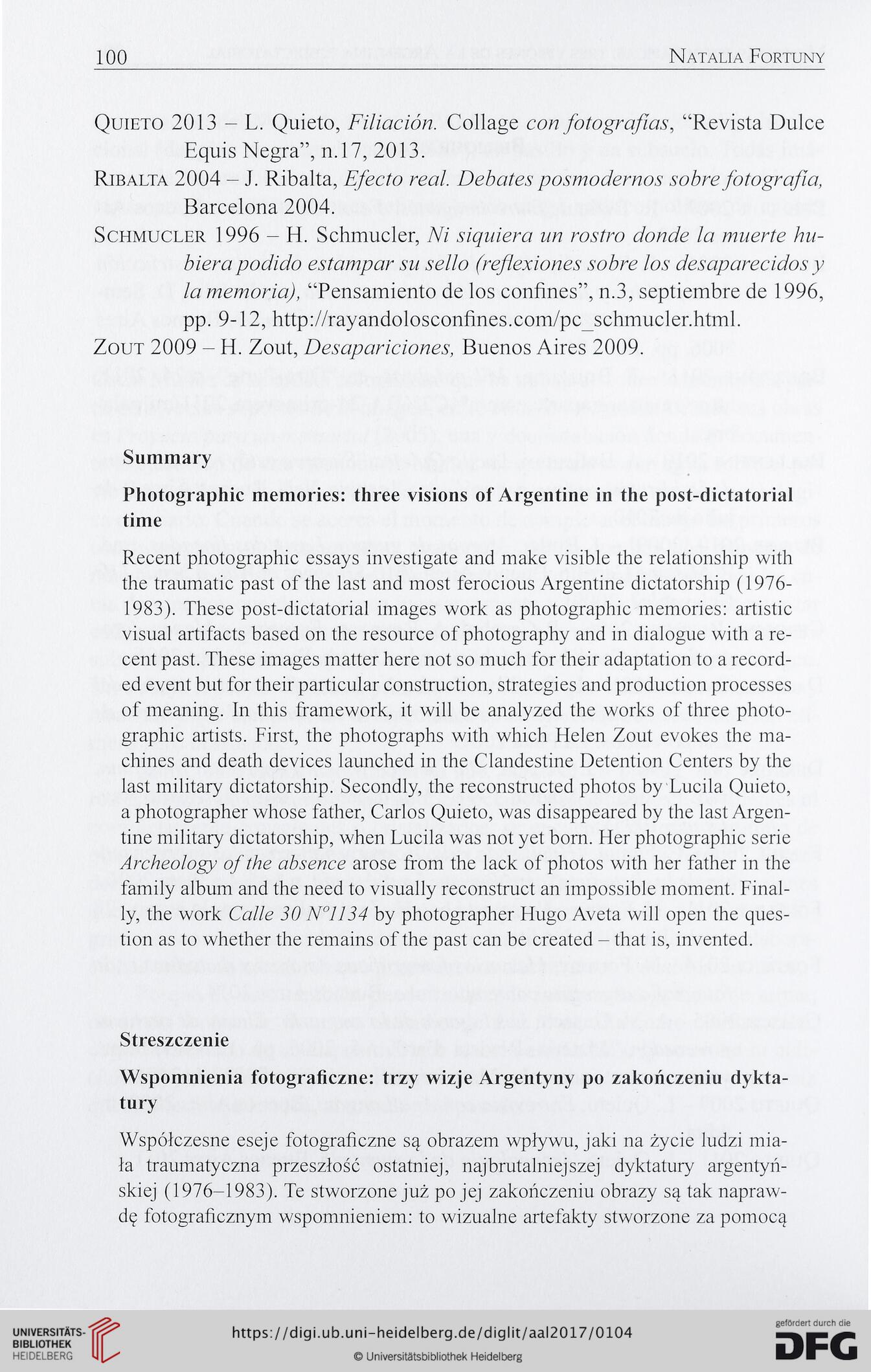100
Natalia Fortuny
Quieto 2013 - L. Quieto, Filiación. Collage con fotografías, ‘‘Revista Dulce
Equis Negra”, n.17, 2013.
Ribalta 2004 - J. Ribalta, Efecto real. Debates posmodernos sobre fotografía,
Barcelona 2004.
Schmucler 1996 - H. Schmucler, Ni siquiera un rostro donde la muerte hu-
biera podido estampar su sello (reflexiones sobre los desaparecidos y
la memoria), “Pensamiento de los confines”, n.3, septiembre de 1996,
pp. 9-12, http://rayandolosconfines.com/pc_schmucler.html.
Zout 2009 - H. Zout, Desapariciones, Buenos Aires 2009.
Summary
Photographic memories: three visions of Argentine in the post-dictatorial
time
Recent photographic essays investigate and make visible the relationship with
the traumatic past of the last and most ferocious Argentine dictatorship (1976-
1983). These post-dictatorial images work as photographic memories: artistic
visual artifacts based on the resource of photography and in dialogue with a re-
cent past. These images matter here not so much for their adaptation to a record-
ed event but for their particular construction, strategies and production processes
of meaning. In this framework, it will be analyzed the works of three photo-
graphic artists. First, the photographs with which Helen Zout evokes the ma-
chines and death devices launched in the Clandestine Detention Centers by the
last military dictatorship. Secondly, the reconstructed photos by Lucila Quieto,
a photographer whose father, Carlos Quieto, was disappeared by the last Argen-
tine military dictatorship, when Lucila was not yet born. Her photographic serie
Archeology of the absence arose from the lack of photos with her father in the
family album and the need to visually reconstruct an impossible moment. Final-
ly, the work Calle 30 N°1134 by photographer Hugo Aveta will open the ques-
tion as to whether the remains of the past can be created - that is, invented.
Streszczenie
Wspomnienia fotograficzne: trzy wizje Argentyny po zakończeniu dykta-
tury
Współczesne eseje fotograficzne są obrazem wpływu, jaki na życie ludzi mia-
ła traumatyczna przeszłość ostatniej, najbrutalniejszej dyktatury argentyń-
skiej (1976-1983). Te stworzone już po jej zakończeniu obrazy są tak napraw-
dę fotograficznym wspomnieniem: to wizualne artefakty stworzone za pomocą
Natalia Fortuny
Quieto 2013 - L. Quieto, Filiación. Collage con fotografías, ‘‘Revista Dulce
Equis Negra”, n.17, 2013.
Ribalta 2004 - J. Ribalta, Efecto real. Debates posmodernos sobre fotografía,
Barcelona 2004.
Schmucler 1996 - H. Schmucler, Ni siquiera un rostro donde la muerte hu-
biera podido estampar su sello (reflexiones sobre los desaparecidos y
la memoria), “Pensamiento de los confines”, n.3, septiembre de 1996,
pp. 9-12, http://rayandolosconfines.com/pc_schmucler.html.
Zout 2009 - H. Zout, Desapariciones, Buenos Aires 2009.
Summary
Photographic memories: three visions of Argentine in the post-dictatorial
time
Recent photographic essays investigate and make visible the relationship with
the traumatic past of the last and most ferocious Argentine dictatorship (1976-
1983). These post-dictatorial images work as photographic memories: artistic
visual artifacts based on the resource of photography and in dialogue with a re-
cent past. These images matter here not so much for their adaptation to a record-
ed event but for their particular construction, strategies and production processes
of meaning. In this framework, it will be analyzed the works of three photo-
graphic artists. First, the photographs with which Helen Zout evokes the ma-
chines and death devices launched in the Clandestine Detention Centers by the
last military dictatorship. Secondly, the reconstructed photos by Lucila Quieto,
a photographer whose father, Carlos Quieto, was disappeared by the last Argen-
tine military dictatorship, when Lucila was not yet born. Her photographic serie
Archeology of the absence arose from the lack of photos with her father in the
family album and the need to visually reconstruct an impossible moment. Final-
ly, the work Calle 30 N°1134 by photographer Hugo Aveta will open the ques-
tion as to whether the remains of the past can be created - that is, invented.
Streszczenie
Wspomnienia fotograficzne: trzy wizje Argentyny po zakończeniu dykta-
tury
Współczesne eseje fotograficzne są obrazem wpływu, jaki na życie ludzi mia-
ła traumatyczna przeszłość ostatniej, najbrutalniejszej dyktatury argentyń-
skiej (1976-1983). Te stworzone już po jej zakończeniu obrazy są tak napraw-
dę fotograficznym wspomnieniem: to wizualne artefakty stworzone za pomocą




